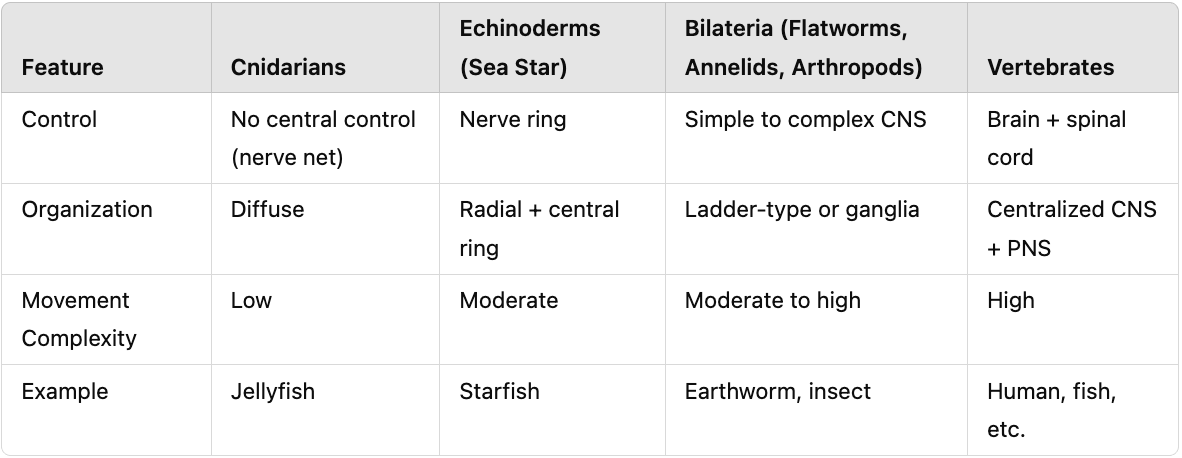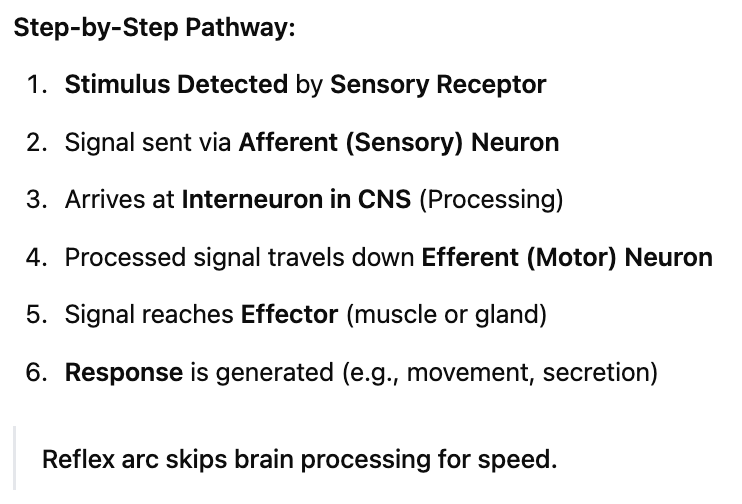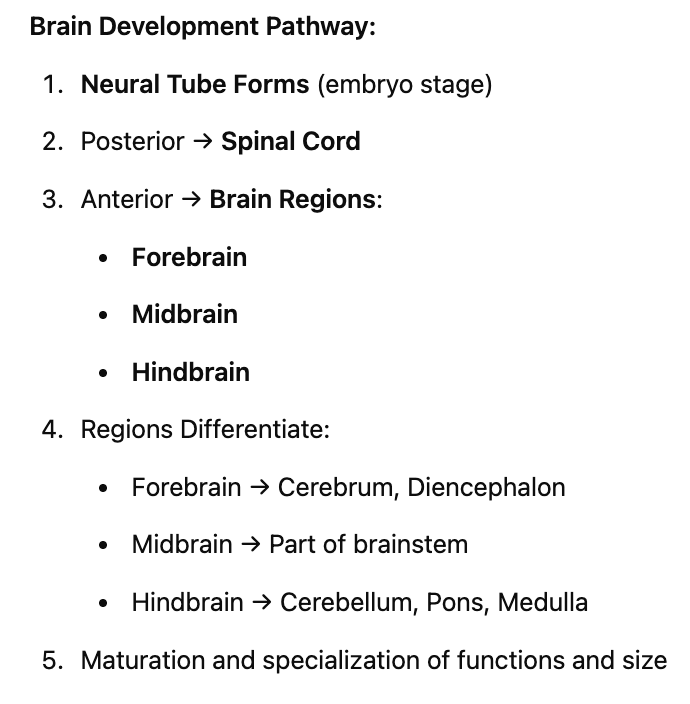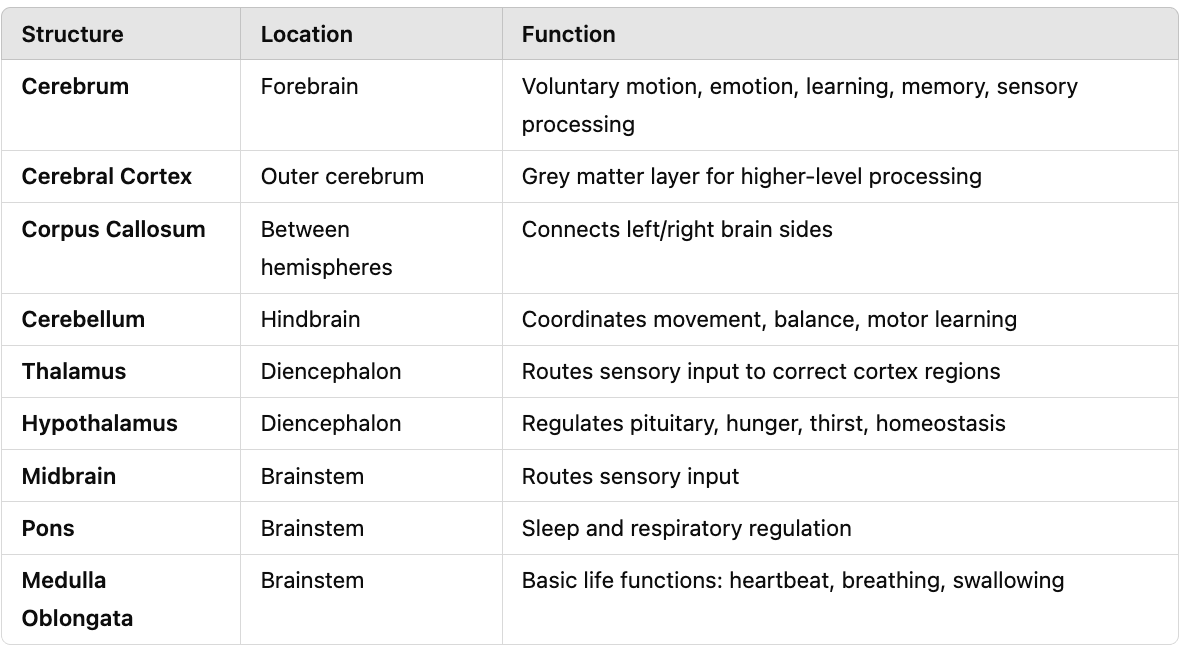Topic 16- Nervous System Organization
Outcomes:
• compare and contrast animal nervous systems

• compare and contrast the types of glial cells

• compare and contrast the CNS and PNS

• sequence nervous system signaling pathways

• sequence brain development

• compare and contrast brain structures

I. Nervous System Overview
Enables organisms to sense and react to the environment
Increases survival and reproduction in changing conditions
Higher organism complexity → more complex nervous systems
A. Evolutionary Examples
Cnidarians
Simplest animals with a nervous system
No central control → nerve net
Sea Stars (Echinoderms)
Central control present
Nerve ring signals muscles
Bilateria
Wide variety in nervous system structure
Platyhelminthes: simple CNS, brain, eyespots, ladder-type structure
Annelids/Arthropods: more complex brains and ganglia
Vertebrates
CNS: Brain and spinal cord
PNS: Nerves and ganglia
Nervous System vs. Lifestyle
Chiton: slow, simple nervous system
Squid: fast, complex nervous system
II. Glial Cells
A. Adult Glial Cells (Support CNS)
Microglia
Scavenge dead cells
Protect brain from microorganisms
Astrocytes
Assist blood and nutrient flow to neurons
Form the blood-brain barrier
Ependymal Cells
Produce, circulate, and support cerebrospinal fluid (CSF)
Myelin-producing Glia
Oligodendrocytes (CNS): myelinate multiple axons
Schwann cells (PNS): myelinate one axon each
Myelin: Insulates axons, speeds up signal conduction
B. Radial Glia
Form tracks in the developing embryo for neuron migration
May aid in synaptic plasticity in adults
Develop into other glial cell types
III. Central Nervous System (CNS)
A. Brain
Central control organ
Structure:
Ventricles: fluid-filled cavities
Grey matter (cell bodies) surrounds
White matter (myelinated axons)
Filled with cerebrospinal fluid (CSF)
B. Spinal Cord
Structure:
Central canal with CSF
Grey matter surrounds canal
White matter surrounds grey
Functions:
Relay signals to/from brain
Interneurons connect to PNS
Reflexes:
Rapid, involuntary
Example: knee-jerk to prevent falling
IV. Peripheral Nervous System (PNS)
A. Sensory Receptors
Detect visual, auditory, and other stimuli
Transmit info to/from CNS
B. Nerves
Cranial Nerves
Originate in hindbrain
Serve head and upper body
Spinal Nerves
Originate in spinal cord
Serve entire body
C. Organization
1. Afferent Pathway (Sensory) – Arrives at CNS
From receptors, not effectors
Two types of input:
Visceral: unconscious (e.g., blood pressure)
Somatic: conscious (e.g., sight)
Signal travels to interneurons for processing
2. Efferent Pathway (Motor) – Exits from CNS
Sends signals to responders (effectors)
a) Motor System
Targets: Skeletal muscle
Includes voluntary and reflex actions
No sensory receptors involved
b) Autonomic Nervous System
Targets: Glands, heart, smooth muscle
Controls involuntary functions:
Digestive
Cardiovascular
Excretory
Endocrine
Divided into:
Enteric: digestive system
Parasympathetic: "rest and digest" : parachute
Sympathetic: "fight or flight"
V. Vertebrate Brain
A. Brain Development
All vertebrates start with a neural tube
Posterior → spinal cord
Anterior → brain regions:
Forebrain
Midbrain
Hindbrain
Relative sizes vary by species
Size reflects functional importance
B. Brain Structure & Function
Grey Matter: Neuron cell bodies and dendrites
White Matter: Myelinated axons
Left & Right Hemispheres: Opposite perception and control
Corpus Callosum: Connects hemispheres (thick axon bundle)
C. Major Brain Regions
1. Cerebrum
Two hemispheres + cortex
Cerebral cortex (outer grey layer):
Voluntary movement
Learning
Emotion
Memory
Sensory processing
Derived from the forebrain
2. Cerebellum
Coordinates movement and balance
Assists with learned motor skills
3. Diencephalon
Thalamus: Routes sensory input to correct cortex area
Hypothalamus: Regulates pituitary, hunger, thirst
4. Brainstem
Midbrain: Routes sensory input
Pons: Regulates respiration and sleep
Medulla: Controls vital functions:
Breathing
Heartbeat
Blood pressure
Swallowing, coughing, vomiting